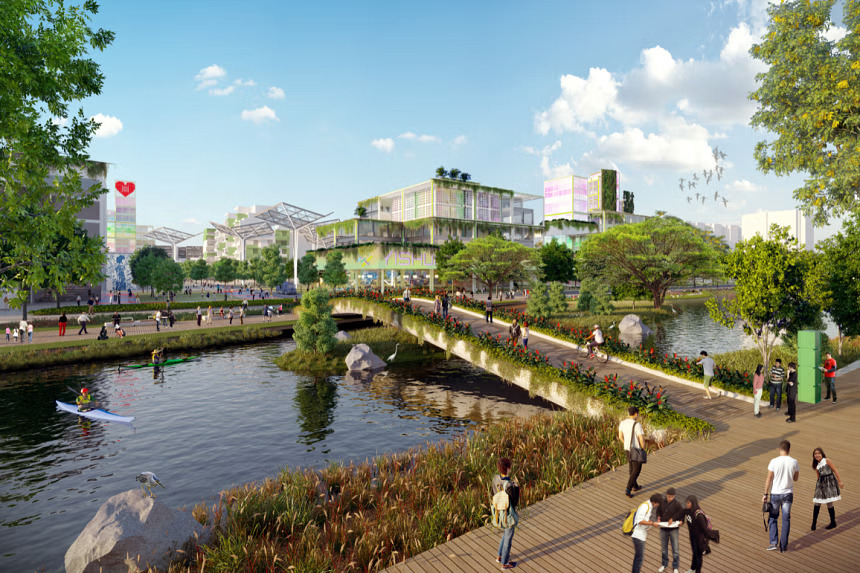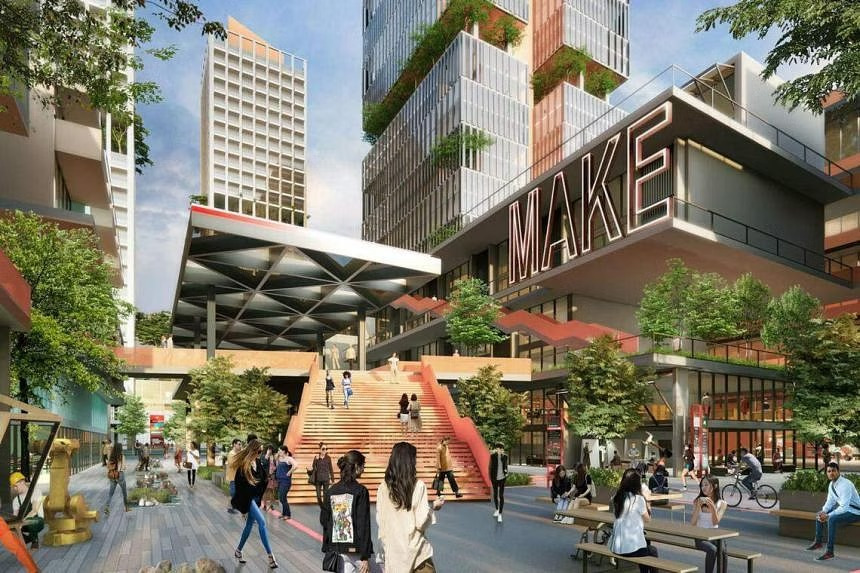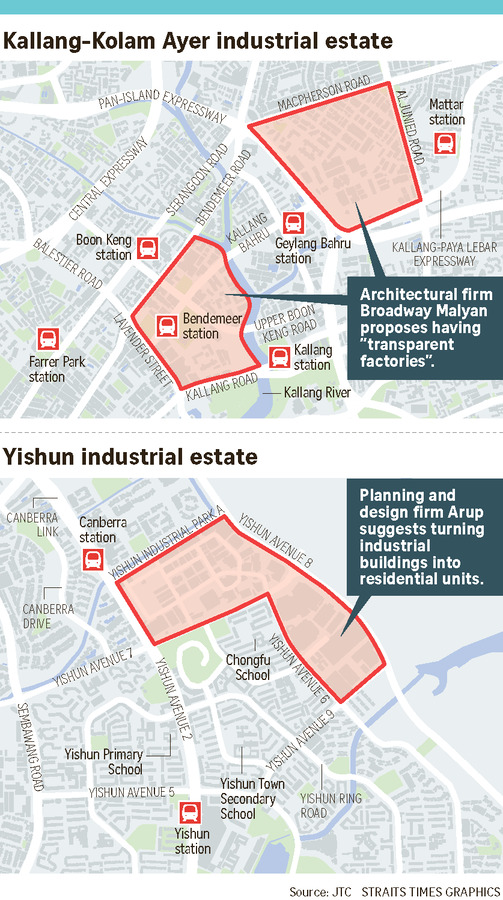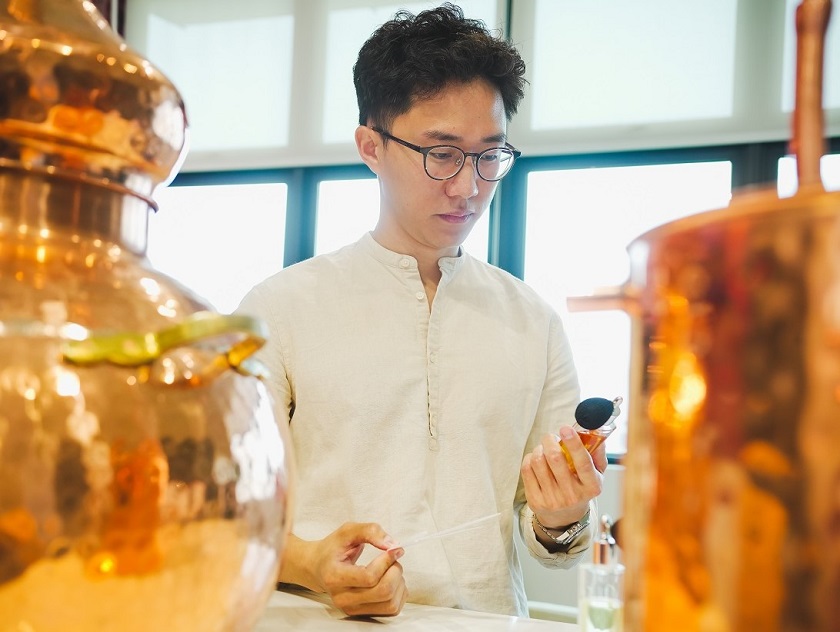
Industrial buildings along a river in Yishun could be repurposed into residential units as part of a proposal to rejuvenate the Yishun industrial estate.
Now occupied by a row of flatted factories, the area facing the river, Sungei Simpang Kiri, could be transformed into a riverfront SoHo (small office/home office), or a place to live, work and play at. This can be done through the addition of bridges, boardwalks, paths and a cycling track.
The suggestion from planning and design firm Arup was among 26 proposals submitted for a competition that JTC Corporation held between February 2020 and March 2021 to reimagine Singapore’s industrial landscape. The shortlisted entries are now being exhibited at The URA Centre in Maxwell Road as part of Archifest, a yearly festival by the Singapore Institute of Architects.
Architectural, planning and design professionals were invited to put forth ideas to transform the Yishun and Kallang-Kolam Ayer industrial estates into sustainable and vibrant communities, while retaining existing buildings.
These estates were chosen as there were opportunities to make better use of space by integrating industrial and non-industrial uses, JTC said.
Arup’s proposal titled The Intersections was among seven shortlisted entries.
Under its proposal, the Yishun industrial estate could be connected to surrounding neighbourhoods through a network of greenery-lined paths.
“Here, urban greening plays a crucial role in achieving this goal, not only by creating a vibrant green neighbourhood, but also by mitigating the heat generated in the estate,” said the firm.
In a separate proposal, architectural firm Broadway Malyan mooted the idea of introducing “transparent factories” to the Kallang-Kolam Ayer industrial estate.
At these factories, ground-floor spaces could be made more open and inviting to engage the public.
Showrooms and product galleries could offer visitors an immersive experience, where they can interact with innovative production processes, and customise products and designs.
JTC said this could be an avenue to promote industrial tourism.
The rooftops of these factories could also be transformed into large green spaces, based on Broadway Malyan’s proposal titled Singapore Makers Land.

The firm also suggested having a building called The Summit at the western edge of Kallang to test the use of robots that will complement humans in factory production processes. This would allow the Kallang-Kolam Ayer industrial estate to cater to high-tech industries, it said.
Meanwhile, architectural firm Woha proposed having a network of rivers and canals in Kallang-Kolam Ayer allowing water-based personal mobility devices, water ferries and taxis to navigate the estate.
JTC said it would review the proposals from the competition and identify suitable ideas to help in the planning of the two estates, and other mature industrial estates such as an eco-district at Sungei Kadut in Kranji.
Responding to queries from The Straits Times, Ms Tang Hsiao Ling, director of JTC’s urban planning and architecture division, said JTC was unable to set out a schedule for rolling out the ideas because of the long leases of existing companies. Where there are vacant sites, she said it would study how to put some of the ideas into effect.
JTC, the government agency overseeing Singapore’s industrial development, said it wanted to explore opportunities to help its estates “remain adaptive” to emerging trends and future technologies.
The proposals explored concepts such as how the two estates could integrate technologies, such as autonomous goods vehicles and robots, to create more efficient and sustainable production processes.

Repurposing existing industrial buildings is also more sustainable than tearing them down and putting up new structures, said JTC. This also preserves the heritage of the estates.
Ms Tang said it was critical for the agency to continuously examine new ways to optimise industrial land, given Singapore’s space constraints.
“The bold concepts put forth for Yishun and Kallang-Kolam Ayer industrial estates are inspiring in envisioning how the future of mature industrial estates may look like,” she said.
The shortlisted proposals are on display until Oct 20, and the public can provide feedback on them at www.go.gov.sg/archifest2023exhibition.
Architectural, planning and design professionals were invited by JTC to submit ideas on transforming the Yishun and Kallang-Kolam Ayer industrial estates into sustainable and vibrant communities.

Speaking at Friday’s launch of Archifest, Ms Indranee Rajah, Minister in the Prime Minister’s Office and Second Minister for National Development, said the Urban Redevelopment Authority (URA) would continue tying up with architects and built-environment professionals in an upcoming Draft Masterplan exercise to brainstorm more innovative ideas catering to Singapore’s future needs and aspirations.
Archifest, which runs till Oct 28, features a line-up of events as well as six urban installations around Kampong Gelam that provide deeper insight into the area’s heritage.
One of the installations, Dulang-Dulang, is a long table made up of the symbolic food trays in Malay culture. It is located in the parking zone for coaches and cars at Sultan Gate.
The installations received backing from the Housing Board and URA’s Lively Places Fund, which grants up to $20,000 to projects that transform public spaces.Beyond space limitations, Singapore’s tropical climate with its frequent cloudy and rainy weather poses another challenge. This can affect the power grid’s reliability as solar power output fluctuates even with just a passing cloud.
Source: The Straits Times © SPH Media Limited. Permission required for reproduction.

